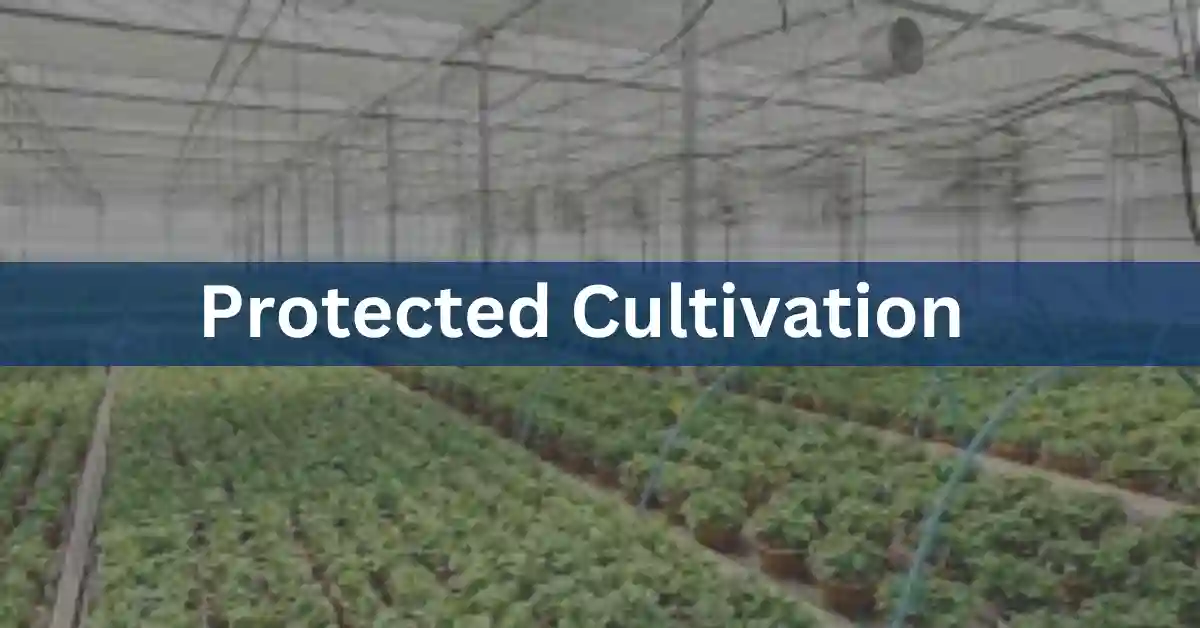Protected cultivation was developed as a result of the need to shield crops from adverse conditions. The most practical way to achieve the goals of protected agriculture is to grow plants in a greenhouse, which alters the natural environment using sound engineering principles to maximize plant growth and yield. Indian agriculture’s polyhouse cultivation has evolved into a significant policy.
Following the green revolution, a greater emphasis has been placed on the quality of agricultural products as well as the quality of production to meet the ever-increasing requirements for food and nutrition. When the conditions for the growth of the plant are appropriately controlled, both of these requirements can be met.
What is protected cultivation?
A cropping system known as protected cultivation practices is one in which the microclimate surrounding the plant body is partially or completely controlled by the requirements of the vegetable or flower species that are grown during their growth period. As agriculture has progressed, a variety of protected cultivation methods that are appropriate for a particular agroclimatic zone have emerged. The Telangana State can benefit from these protective cultivation practices, such as the shade house, greenhouse, plastic house, cloth house, net house, and so on.
A greenhouse is a structure that is framed or inflated and covered with a transparent or translucent material. It is large enough for a person to work in it to perform cultural operations and allows crops to be grown in an environment that is at least partially controlled.
The majority of structures used for the controlled production of ornamental and vegetable crops are greenhouses. These structures can control all environmental parameters, though the degree of control varies depending on the structure’s design and its components.
Advantages or Importance of Protected Cultivation:
- The crop is shielded from frost, cold, wind, storm, and rain.
- Germination, plant growth, and crop maturity are all improved under controlled conditions.
- Increased produce quantity and quality with a longer shelf life.
- Water efficiency is improved, and water consumption is reduced by 40 to 50 percent.
- Efficient use of the inputs.
- Diseases and pests are either reduced or eliminated.
- Crops can be grown all year long.
- The best technology for commercializing high-value crops like flowers and medicinal plants, among others.
- Can be used to dry farm produce using sunlight.
- It is possible to reduce workforce involvement.
- Cultivate crops in adverse weather conditions.
- Certain crops are grown all year to meet market demands.
- Crops were grown in export markets of high value and quality, even organic ones.
- The small landholdings’ income increased several times.
- From seeds or vegetative propagation, successful nurseries can be created whenever necessary.
- On the farm, more opportunities for self-employment for educated youth.
- Plant breeding through the manipulation of the greenhouse’s microclimate and insect-proof design, resulting in the development of new varieties and the production of seeds.
Scope of Protected Cultivation in India:
Indian horticulture has a huge potential. The promising fields with a large potential for protected cultivation in India are popularly organized.
1. Agriculture in a challenging climate:
The majority of uncultivated land in India is in difficult conditions, including deserts and barren, uncultivated fallow lands. The locals could benefit greatly from purchasing even a small portion of this land for greenhouse cultivation.
2. Around major cities, greenhouses:
In major cities, there is always a significant demand for fresh vegetables and ornamentals. In large cities, there is also demand for off-season and high-value crops. As a result, greenhouse farming can be promoted to meet urban needs.
3. Produce from horticulture is exported:
Internationally, there is a significant demand for horticultural products, particularly cut flowers. Export promotion will benefit from encouraging the greenhouse cultivation of export-oriented crops. Ex. Gherkins are grown in greenhouses around Hyderabad and exported to various nations.
4. Propagation of greenhouses for plants:
Nowadays, GH technology is regarded as a suitable method for raising seedlings and cuttings that require a controlled environment for growth. The capacity of the GH facility to produce plant material could be increased.
5. Biotechnology greenhouse technology:
Tissue culture-generated material must be propagated in a controlled environment. Controlled environmental conditions are also required for growing plants using hydroponics or the Nutrient Film Technique (NFT).
6. Growing rare and medicinal plants in a greenhouse:
Many medicinal herbs and rare plants in India can be grown on a large scale, like orchids. For intensive cultivation of these plants, the greenhouse might provide the right kind of environment.
Status of protected cultivation in India
The Indo-Israel project on greenhouse cultivation, which was started at the Indian Agricultural Research Institute (IARI) in New Delhi in 1998, shortly after diplomatic ties with that country were established, was India’s first exposure to truly high-tech protected farming of vegetables and other high-value horticultural produce. Even though the Israeli specialists left India in 2003, IARI continued to maintain the facility, naming it the Centre for Protected Cultivation Technology (CPCT).
In addition to tailoring greenhouse structures to local conditions, it has been able to reduce costs over the past ten years by improving and refining the system. By the end of the 20th century, greenhouse cultivation had spread to over 275,000 hectares worldwide and covered approximately 110 ha in India.
This area must have grown by at least 10% over the past decade. Andhra Pradesh, Gujrat, Maharashtra, Haryana, Punjab, Tamil Nadu, and West Bengal are the states that have consistently increased the protected cultivation area between 2007 and 2012. Up until 2012, the protected cultivation areas in Gujrat and Maharashtra totaled 4,720.72 hectares and 5,730.23 hectares, respectively.

